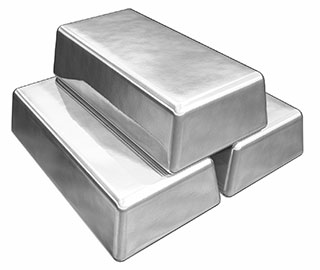Silver – Why It’s Better Than Gold
Why should you invest in silver? What’s the difference, from an investment perspective, between silver and gold? Allow me share my thoughts.
First, for the record, let me state that I am a fan of gold. I believe there is a place for gold in everyone’s portfolio, and that’s why I’ve posted articles on Physical Gold and Silver – The Ultimate Insurance Policy, How to Buy Physical Gold, and Where to Store Physical Gold and Silver. Both gold and silver can function as money, because they both have the five “D’s”:
- durable (they don’t rot or go bad, which is why we don’t use fruits and vegetables as money);
- dense, meaning they have a high value to weight ratio (we could use feathers as money, but you’d need really big bags of the stuff);
- divisible, because you can chop up or melt down a bar, relatively inexpensively, and still have something of value;
- not dissimilar, meaning every one ounce piece of pure gold or silver is the same as any other one ounce piece of pure gold (which is not the case for a one ounce diamond, or a one acre parcel of land); and
- difficult to counterfeit (it’s difficult to create “fake” gold or silver).
Of course the other obvious characteristic of both gold and silver are that they are real. You can touch them, and hold them. That’s more than you can say for the derivatives you own, or even the money in your bank account, which ultimately are nothing more than computer electronic blips on your computer screen.
If you own gold and silver, you own it. Do you really own your house? Sort of, but only if you keep paying your property taxes, or else the government will take it.
Do you own the shares in your brokerage account? Sort of, unless your broker fails. Do you own bonds? Yes, until the creditor stops paying. With gold and silver there is no counter-party risk; there is no-one on the other side of the transaction you need to trust.
So how is silver different than gold? I can think of a few reasons:
1 Silver has more uses than gold. Both silver and gold are used in jewelry and coins, and in electronics (they are great conductors), but silver also has other traditional uses like photography and silverware, and industrial uses in batteries, bearings, brazing and catalysts, and in new uses in solar energy, medical applications, and water purification. Gold is the most malleable metal (you can smash it until it’s paper thin); silver is the second most malleable metal. Silver is very valuable as an industrial metal because it is the most reflective metal, and is a great conductor of heat and electricity.
2 Silver is cheaper, per ounce, than gold. That means if the “average Joe” decides to invest in precious metals, it will be easier for him to buy an ounce of silver at $50 per ounce than it would be to buy an ounce of gold at $1,500 per ounce.
3 Central banks have at least some silver in their vaults; they have no silver. That means there is no risk of them dumping silver to depress it’s price, since they have nothing to dump!
4 Gold is mined as a primary product; silver is mined mostly as a bi-product of other mining (mostly zinc). That means that to increase supply you can’t simply open up a bunch of new mines; it’s only if zinc production increases will silver production significantly increase.
5 Silver is used up. Gold isn’t. Most of the gold ever mined still exists today. Silver, however, is consumed in photography, electronics, batteries, and other applications, and now resides, in tiny amounts, in landfills. Eric Sprott estimates that approximately 46 billion ounces of silver have been mined since the dawn of civilization, as compared to 5 billion ounces of gold. However, of those 46 billion ounces, only about 1 billion ounces of silver remain available in bullion form today (as compared to 2 billion ounces of gold). Clearly silver is “used up” much more than is gold. (You can read Sprott’s thoughts here). (Note to Eric Sprott: if you are reading this, here’s a good idea for a newsletter for you: Sprott’s Thoughts).
To summarize: gold and silver are both precious metals, but silver has more uses than gold, is cheaper per ounce and therefore more accessible to the common man, can’t be dumped by central bankers, is difficult to rapidly increase production, and it gets used up. That’s why silver should be a significant component of the prudent portfolio.
